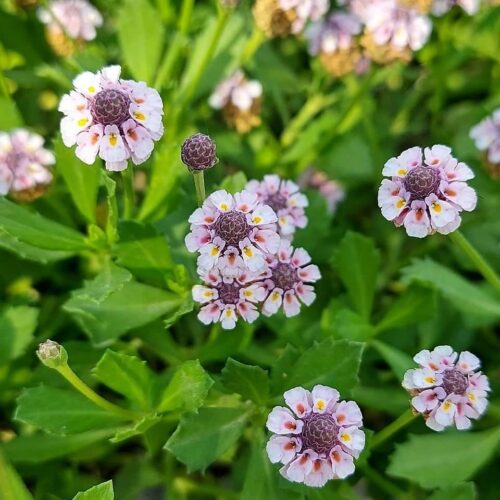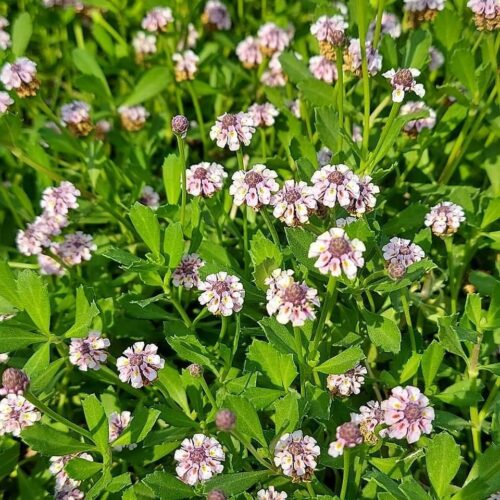Frog Fruit is a beautiful ground cover herbaceous plant that produces white and light purple blooms. It is adaptable to all soil types.
Frog fruit flourishes in dry soil conditions but experiences dieback during freezing temperatures, with complete demise after prolonged freezes. In the wild, they flourish in challenging locations such as ditches, beaches, and fields. Now, the question arises: can you incorporate these native frog fruit plants into your landscaped garden?
Common Names: Turkey Tangle Fogfruit, Carpet Weed, Capeweed, and Matchhead
Read: Weeds with Purple Flowers
What is Frog Fruit?

Frog fruit, scientifically known as Lippia nodiflora (syn. Phyla nodiflora), goes by the interesting name “turkey tangle frog fruit.” This native North American plant belongs to the Verbena family, showcasing its unique charm in the world of flowering herbaceous plants. It can reach up to 3 to 5 inches tall (7.5 to 13 cm.). These plants grow in the wild across the southern United States to tropical regions.
The distinctive flowers of frog fruit appear in the landscape from May to October and show off elegant white blooms with five petals arranged on 4-inch (10 cm.) long spikes.
It has a spreading habit that covers nearly 3 feet (1 m.) and forms a dense mat of semi-woody stems. These plants boast attractive leaves adorned with small notched indents along the edges.
Including this ground cover in a native woodland garden not only adds aesthetic appeal but also serves as a food source for deer. Additionally, the plant can act as a beneficial sacrificial species if deer pose problems in other areas of the garden.
Read: Tievine Care and Growing Information
How to Propagate Frog Fruit
Frog fruit exhibits rapid growth when directly sown from seed after the soil has warmed or through cuttings. Its prolific self-seeding nature may lead to an invasive tangle if not managed. While the plant remains evergreen in most native regions, it sheds leaves in temperate climates during the arrival of cold temperatures in the fall. Typically, it regenerates in spring unless the root zone experiences severe freezing temperatures.
Read: Moon Lilies Growing and Care
Ideal Growing Conditions for Frog Fruit
Location
It grows well in both full and partial shade. While optimum growth and abundant blooms appear in full sun, planting in partial shade won’t adversely affect its vigor or make it more susceptible to diseases; it simply results in fewer blooms.
Soil
Grow this ground cover in well-draining soil. In its natural habitat, frog fruit thrives in diverse locations such as roadside ditches, beach dunes, and recently burned forests. Its popularity as a landscaping plant is attributed to its ability to adapt to different soil conditions. It does not require soil amendments while planting
Water
The primary focus in caring for this ground cover during its establishment phase is watering. Although the species is drought-tolerant, providing additional irrigation during dry and hot periods is beneficial. In general, the main period demanding substantial care for your plants is during their maturation, requiring consistent watering.
Temperature and Humidity
Frog fruit prefers warm weather and is well-suited to humid conditions. In such climates, it retains its evergreen or semi-evergreen nature even in warm winters. While it excels in drought-resistant qualities and adapts to both dry and humid environments, it is sensitive to cold temperatures.
By maintaining frog fruit within the recommended USDA zones of 7-11, you can ensure that your plants flourish and maintain their attractive appearance throughout the year.
Read: Amaryllis Flower Meaning and Symbolism
Frog Fruit Care

Fertilizer
Apply a liquid bloom fertilizer to boost the flowering. Opt for a commercially available NPK formula of 2-6-4, and your frog fruit will thrive and maintain good health.
Pruning
You don’t need to prune frog fruit, but it’s fine to do so if it spreads too much or grows too long. If you decide to prune, it’s best to do it after the last flowers are gone. You can use garden snips or sharp scissors; just make sure to clean them with alcohol.
It is often used as a ground cover or an alternative to grass, and you can even mow it if you like.
Pests and Diseases
The main issue with frog fruit is that newly planted ones can suffer in very dry conditions. To fix this, simply water them more.
Insects are usually not a problem because the plant attracts insects that keep away the ones that might harm it. It’s a low-maintenance plant, making it a good choice for ground cover.
Frog Fruit As a Groundcover
Frog fruit is popularly used as a groundcover. It is getting a lot of attention because it’s a great choice instead of other non-native ground covers. It is easy to take care of and helps the local environment.
After you plant it and water it a bit, you can let it grow on its own for the season. It will spread on its own until it covers the area you want. The best part is that it can spread well, even over and between things that other ground covers might not grow.
Read: Thunbergia Erecta Clockvine Care
FAQs
1. How to Encourage More Blooms?
To make this ground cover have more flowers, just fertilize it every spring with good liquid bloom fertilizer. Also, give it enough water and sunlight. This way, you’ll have lots of pretty blooms to enjoy, and it’ll attract visiting pollinators.
2. What Do Frog Fruit Blooms Look and Smell Like?
The flowers aren’t very ornamental. They are small and have pink or white petals around a purple center. The smell is gentle but nice, kind of like a faint lilac scent.



